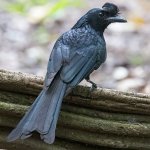Aladdin
Well-known member

Dear members and bird watchers!
Drongo from earlier today. Kaeng Krachan in Thailand
My book Birds of Thailand only have one bird with the curling backward crest and this is the Greater racket-tailed. But the bird have red eye and my bird have black eye.
There is another bird with crest, the Hair-crested Drongo, but this crest looks, yes, like hair strands.
Can my bird, please see attached picture be a Greater Racket-tailed Drongo that have lost the streamers?
I have seen several with only one streamer.
All help would be appreciated
Kind regards and happy birding
Aladdin
Drongo from earlier today. Kaeng Krachan in Thailand
My book Birds of Thailand only have one bird with the curling backward crest and this is the Greater racket-tailed. But the bird have red eye and my bird have black eye.
There is another bird with crest, the Hair-crested Drongo, but this crest looks, yes, like hair strands.
Can my bird, please see attached picture be a Greater Racket-tailed Drongo that have lost the streamers?
I have seen several with only one streamer.
All help would be appreciated
Kind regards and happy birding
Aladdin




